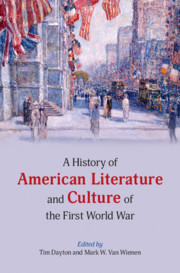Book contents
- A History of American Literature and Culture of the First World War
- A History of American Literature and Culture of the First World War
- Copyright page
- Contents
- Figures
- Contributors
- Acknowledgments
- Introduction America’s Great War at One Hundred (and Counting)
- Part I Genre and Medium
- Part II Settings and Subjects
- Chapter 9 The Peace Movement
- Chapter 10 Americans in France
- Chapter 11 German Americans
- Chapter 12 The English in America
- Chapter 13 Preparedness
- Chapter 14 Propaganda
- Chapter 15 Conscientious Objectors
- Chapter 16 Volunteers
- Chapter 17 African Americans
- Chapter 18 In the Midwest
- Chapter 19 In the South
- Chapter 20 Revolution
- Chapter 21 Monuments and Memorials
- Part III Transformations
- References
- Index
Chapter 19 - In the South
Three Mississippi Writers and the Great War Mobilization
from Part II - Settings and Subjects
Published online by Cambridge University Press: 23 January 2021
- A History of American Literature and Culture of the First World War
- A History of American Literature and Culture of the First World War
- Copyright page
- Contents
- Figures
- Contributors
- Acknowledgments
- Introduction America’s Great War at One Hundred (and Counting)
- Part I Genre and Medium
- Part II Settings and Subjects
- Chapter 9 The Peace Movement
- Chapter 10 Americans in France
- Chapter 11 German Americans
- Chapter 12 The English in America
- Chapter 13 Preparedness
- Chapter 14 Propaganda
- Chapter 15 Conscientious Objectors
- Chapter 16 Volunteers
- Chapter 17 African Americans
- Chapter 18 In the Midwest
- Chapter 19 In the South
- Chapter 20 Revolution
- Chapter 21 Monuments and Memorials
- Part III Transformations
- References
- Index
Summary
The First World War was a shock to the US South. When the war started, the South was a provincial region mired in segregation and plantation agriculture, much as it had been before the Civil War. During the war, however, the South mobilized. Nearly one million southerners enlisted; almost all of the nation’s troops trained at bases hastily-constructed in the South, and the war dramatically reshaped the region’s social order. The war brought northerners and southerners into contact on a massive scale, which eroded sectional animosities, it gave African Americans an opportunity to challenge Jim Crow through military service, and it offered women new forms of social, political, and economic agency. All of these changes occurred during the frenzy of wartime. In the South, the war’s full effects were not evident until after the Armistice, when the soldiers returned. The social expansions that happened during the war contracted, but like a deflated balloon misshapen from use, the social order did not return precisely to previous conditions. This essay focus on the works of three Mississippi writers—William Alexander Percy, William Faulkner, and George Washington Lee—who depicted the experiences of soldiers returning from the war and post-war social landscape of the South.
Keywords
- Type
- Chapter
- Information
- Publisher: Cambridge University PressPrint publication year: 2021

